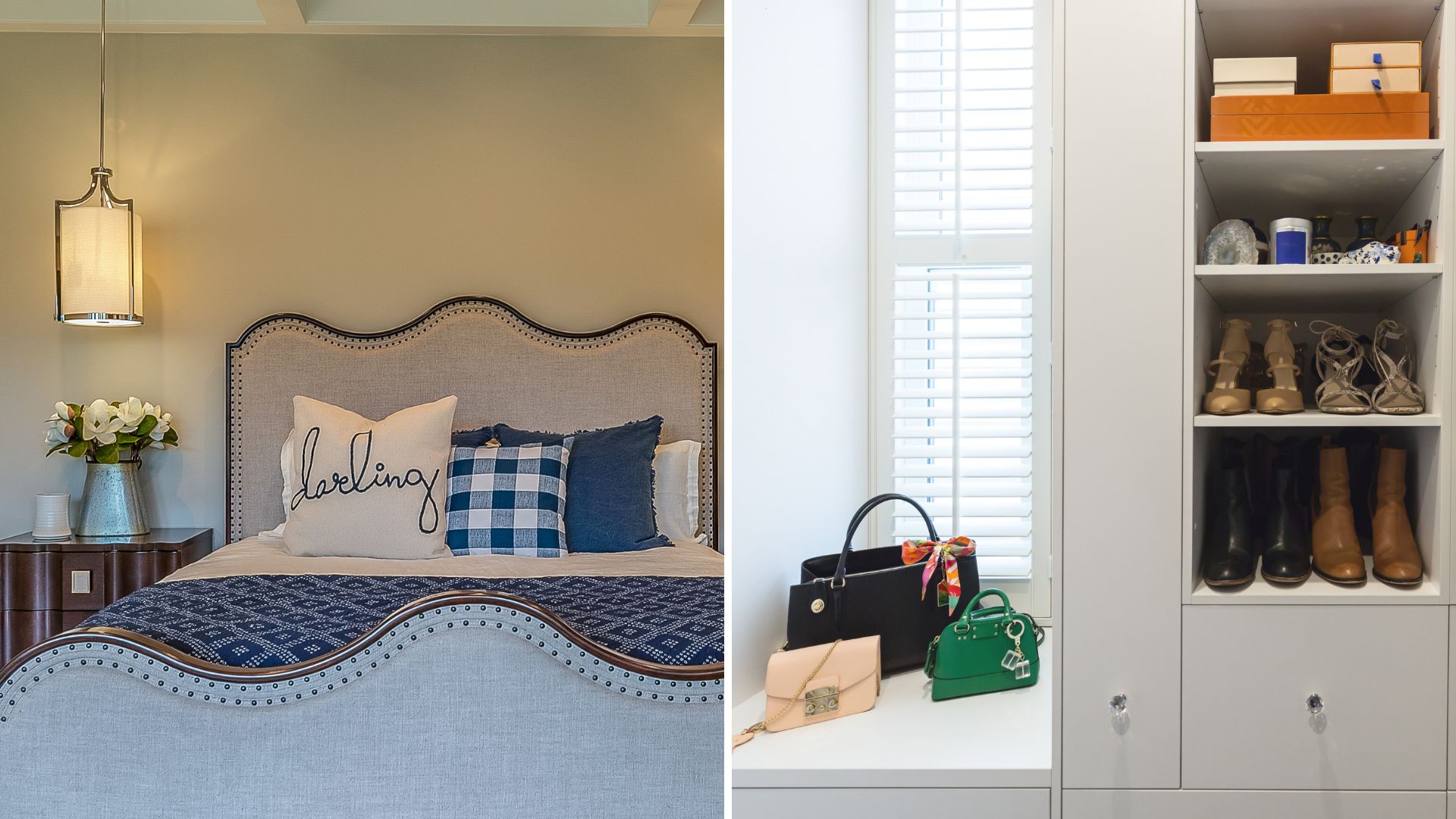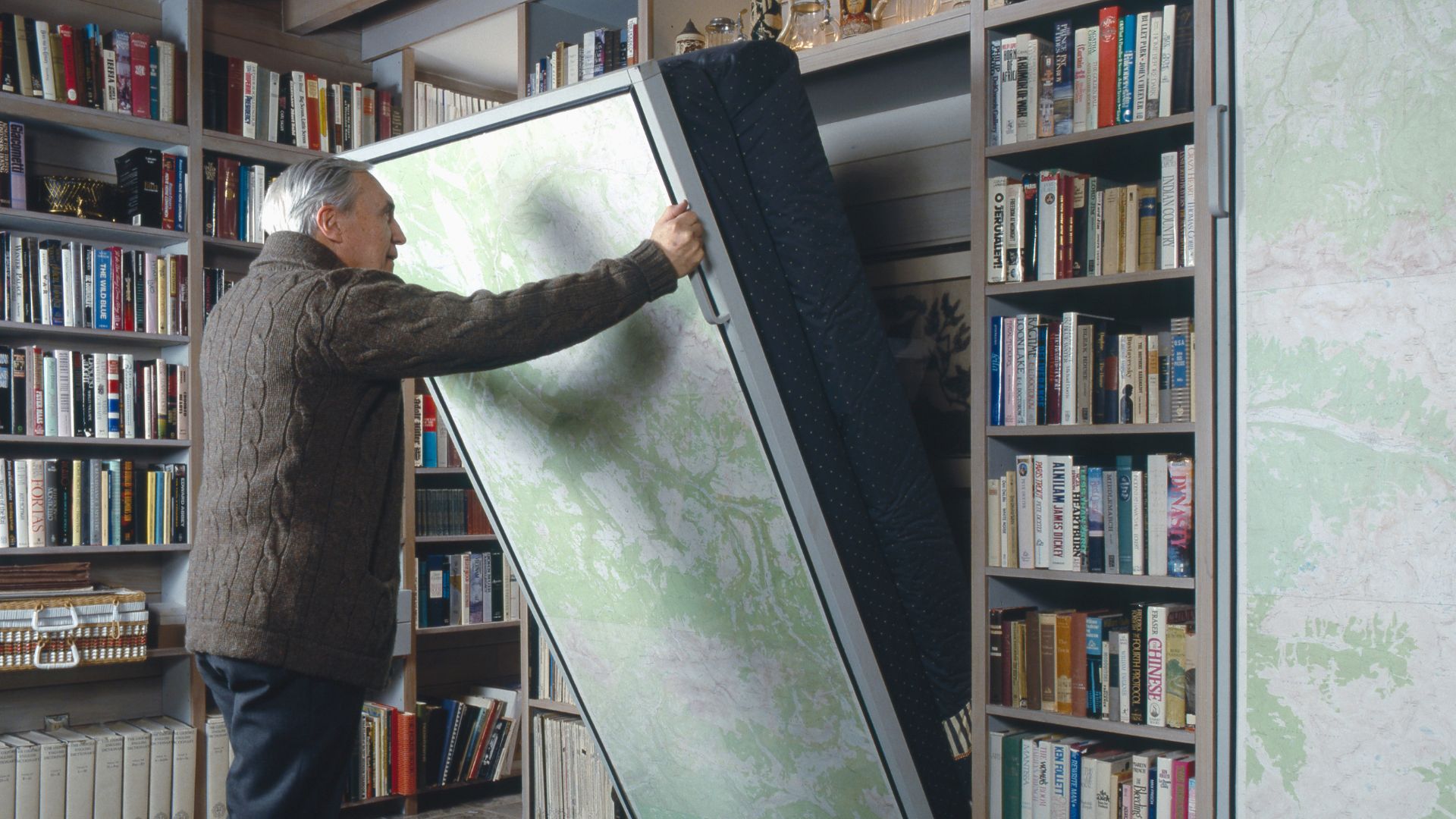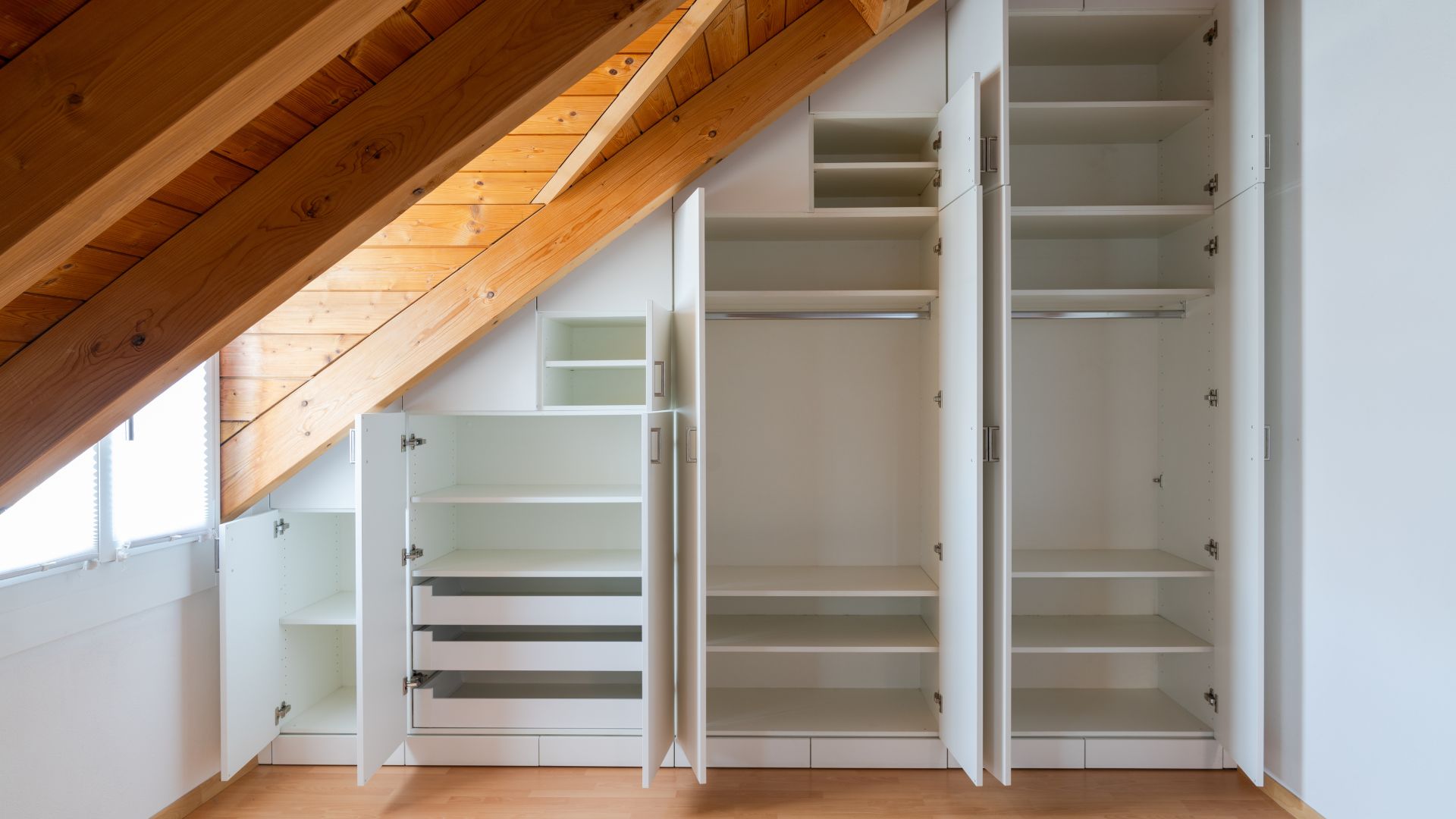
They say that good things come in small packages, but this can feel harder to grasp when it comes to bedroom size.
We all, at first, hope to have a spacious area that can fit all the things that make our daily lives tick on by. But... that's not always the case. For some of us, the very word bedroom becomes almost literal - and you often feel like your room only has space for a bed.
There are plenty of ways to make a living room look bigger, but these don't always translate to the bedroom - a room that's meant to feel more intimate, more personal and more like a sanctuary. But that doesn't mean there's no hope. With the right tips and tricks, you can make a small bedroom feel bigger, or make the most out of the cosy feeling.
32 interior ideas for a small bedroom
Use multifunctional furniture

When you’ve got a small space, you’re going to need everything that can fit into your room to earn its place there - and furniture that pulls double duty will be one of the best investments.
Beds which lift up provide plenty of ‘out of sight’ storage, plus there are a number of other options, like stackable tables that can be put away when not in use or foldable desks and chairs.
Invest in fitted wardrobes

If you have the budget, custom-fitting a wardrobe will maximise your space and make sure you've got exactly what you need.
A custom-designed wardrobe can even be built into typically 'dead' space, such as on corners of the room, meaning you can store your clothes without cutting into your floor space.
Use floating shelves

Floating shelves are relatively affordable and flexible, giving you a chance to change your mind and redesign based on your needs without too much hassle.
The benefit of sturdy shelves is that they allow you to have ample storage space without the need for bulky cabinets that take up excessive room. This makes your space look open and gives the impression of a bigger room.
Plus, they allow you to showcase some of your favourite items in a way that can be seen - coffee table books, antiques, flowers, etc.
Tuck away storage baskets and compartments

With a smaller space, you need to be mindful of what you keep. However, you don’t necessarily have to downsize and get rid of everything.
With storage compartments and extra rails built into cabinets or cupboards, clothes can be sorted and stored away whilst keeping the room looking tidy.
Consider keeping things together, like placing all your sheets and towels in a basket and tucking them at the bottom corner of a wardrobe. You can also use vacuum bags to condense outfits you're not using and store those away.
Use below-the-bed storage

If you haven’t got an ottoman storage bed and you like having a bed with classic posters or raised legs, you can still use the space under without it looking messy.
You can buy specific under-bed storage boxes and baskets, keeping things compact and together, but not looking haphazard.
Similarly, plan what goes below your bed so it still looks neat. Ordering things like books into tidy piles won't look messy if visitors can glimpse under your bed.
Wall panelling can extend a space

Using wall panelling to extend the silhouette of your bed is a common design idea for smaller bedrooms. In fact, many modern builds and aesthetics will use panelling instead of the more traditional headboard or bed frame.
The benefit of panelling is you can further individualise the look - paint them different colours or add personal touches, like mounted lights (and adding lights onto the panels means you can save even more space as you won't need a bedside table or a lamp).
Maximise your window space

However deep or wide they are, no small bedroom should ever forget about using the window space for something.
If you haven't plenty of space, even using it to place some candles, flowers or a jewellery dish will still free up space elsewhere. If you have larger windowsills, you can even make a seating area out of it - all you'll need is some cushions and a cosy throw.
Choose a daybed

Some people need a huge mattress, but if you have a smaller room and you don't plan on having to share the covers with anyone on a regular basis, a smaller daybed can be the best space-saver.
Daybeds are especially useful for small homes or rooms thanks to their versatility and practicality. They offer a unique blend of comfort, style, and functionality, allowing you to go from seating area to sleeping space without much effort.
Make it comfortable by investing in high-quality pillows and bed linen.
Use the foot of the bed

A trunk at the foot of the bed can be a stylish way of keeping your clutter organised - and easily available. While they do tend to be bigger, they can store a large amount of items, and you can make them a focal point of your décor, especially if you choose a vintage style aesthetic.
You can also use the foot of the bed area well by lining up similarly sized pieces of furniture. It’s a convenient spot that you’re probably overlooking anyway, but consider this place to line up a desk or dresser.
Use your head(board)

If you have a headboard, don't forget to use it! If you have the budget, enlist the help of a contractor or designer to build a headboard with some storage shelves or slots for your books, plants, or other bits of decoration.
You can also use a thicker headboard to keep things like lighting, reducing the need of a bedside table or lamp.
Make space by downsizing

While it's not actually an actual interior idea or a trend to consider, any expert will agree that before you start a project, you should always include a step where you properly plan.
This includes planning what you realistically need, and if you’ve been hanging on to clutter for too long. Getting rid of unused or unwanted items could make a smaller space feel less full because you'll only be left with what you want, or what you need.
Consider a leaning ladder

Leaning shelves, a leaning ladder or a leaning bookcase are sort of like a floating layer of shelving steps.
Perfect for small bedrooms, they are sturdy, stylish and promise to save a lot of space, being the ideal solution for storing books, displaying décor or hanging accessories like hats and scarves.
Consider a floating desk

Work from home made simple - and without sacrificing too much of your floorspace.
A wall-mounted shelf doubles perfectly as a personal desk and can be mounted directly to your wall for added efficiency. Less floor space taken up, and you can have more freedom in your room when you don’t need to be sat at your laptop.
You can even consider a foldable mounted floating desk, so you can tuck it down when you're off the clock.
Swap a nightstand for a nesting table

Even small bedrooms benefit from having a table by the bed - it's a great place for your book, lamps, flowers and a night-time drink. However, many bedside tables aren't designed for conservative spaces and they can end up taking up more space than you actually need.
A nesting table tends to be a more streamlined option. With thin legs and a modest table-top, you can use it for practical reasons and you can use the space between the legs (stacking books, putting a basket of things there or placing a large plant, for example).
Make a feature wall

Small in size doesn’t mean small in fun. Having too much going on across your walls could make a space feel cluttered and even smaller, but having one feature wall - be it a bright, bold colour or a wallpapered design - can draw the eye and make the other walls look more elongated. This is especially so if you choose to make the wall behind the bed the feature wall, keeping the other side walls a neutral hue.
Free up space with hanging racks

Hanging racks can be an affordable and stylish addition to any room.
Whether it’s in place of a wardrobe or a smart addition to save up room so you have less things piling up, you can use a set of slim, streamlined hanging racks to store coats or bulkier items.
Swap lamps for string or hanging lights

No matter how large the room, lighting is one of the most important elements in making it just right.
A mixture of tones and the ability to control the lights can immediately make any room feel cosier. To achieve this in a way that'll save plenty of space, instead of a lamp or another bulky light fixture, you can create warm, cosy lighting with hanging lights or fairy lights.
Place artwork up high for an elongated effect

Some of the best design ideas for small bedrooms are surprisingly simple. If you’re planning on hanging art or other photos on your walls, try placing them higher than would be considered normal - literally aim for close to the ceiling, even.
The effect of this is that it draws the eye upwards and creates the illusion of a larger space.
Modernise the Murphy (or foldout) bed

The idea of a Murphy bed - or a foldaway bed that comes down from the wall - used to be something of a shorthand for the worst kind of bachelor pad or the plight of being broke in your first flat.
However, as we become more economical with space and people work and live in the same spaces, the foldout bed has become trendy. So much so, people incorporate the design into their living spaces.
From painting murals to incorporating the exterior into the aesthetic of a small bedroom, get creative with a foldout bed in a small bedroom.
Go bespoke with your fittings

If you have the budget, get a specialist to design for your small room. Not only will this make it unique, you’ll make it more liveable and practical. Do you need a lot of space for books, for example? Have a wrap-around bookshelf made that can fit across two walls. Do you have a slanted roof? Have someone maximise your space with bespoke fittings.
It'll be a touch more costly, but you'll make up for it with no wasted space.
Use vertical stripes

Just like in an outfit, vertical stripes can create the illusion of height when used in a room. The bonus of springing for a vertical patterned wallpaper is that a smaller room will require less of it, too.
Economical and elongating!
Consider different materials for your furniture

If you have a smaller space, you can get creative with the materials you choose for your furniture.
For example, see-through and light acrylic chairs are just as functional as other materials, but their transparency creates the illusion of more light and space than something large and cumbersome, like a big dark desk chair.
Hang up some swing sconces

If you’ve been looking for a stylish way to bring more lighting into your cramped bedroom (without taking up too much space), consider swing-arm wall sconces.
Sconces are mounted on the wall and can articulate at both the wall plate and elbow joint to be positioned exactly how you want. Not only are they much less bulky than most table lamps and light boxes, they can be bent in a way that's less obtrusive.
When in doubt, paint everything white (well, nearly everything)

You can always count on clean white walls to really brighten and open up a cramped bedroom.
It's backed by science. The colour white literally reflects light. In terms of interiors, this makes the walls recede, which helps make a small space seems larger.
White rooms will also look bigger and more open if you have a good source of natural light.
Improvise with your bedframe

In a perfect world, people have all the space in the world to keep their bedrooms a peaceful oasis free of work woes or screen annoyances. But that isn't always the case, and some people have to make a smaller room work for them, and this includes their actual bed.
it isn’t uncommon these days to see people making more of their bed. From built in storage on the sides to making shelves out of the frame, finding a bed frame that has the option for extra storage can really help out a smaller space.
Mirrors can open up a space

It's one of the most simple and reliable tricks when it comes to interior design -mirrors can make a room look bigger.
Strategically place a mirror and it can help to open up and expand the space. Whether it's floor-length styles, or small rounded ones placed on table tops, the more you dot around the room, the brighter it will feel.
Choose a loft bed

If you're short of space, you can build upwards.
The ideal solution if your small bedroom is short on floor space but generous in height, a loft bed - which replicates the feel of a bunk bed, with space for a desk or table on the bottom instead of a second bed - can free up plenty of room.
When picking the best loft bed, also look for a frame that's made of something natural - like wood - instead of solid dark metal, as these are better at reflecting light.
Stick to one colour

To create the feeling of more space in a small room, you can always try sticking to one single colour. This will help create more space as, with no strong focal point and no stark contrasts, you’re less aware of where things stop and start.
Make a nook

If you’ve got a small room, why not go all out and embrace it? Not every small bedroom has to be designed to feel bigger. Some people like the cosiness of an intimate space.
One such way to embrace the feel of a small room is to design the space with more of a nook instead of a typical bed placed in the centre of the room.
Usually extended from the window, you can have a seating or bedding area made into the alcove. It’ll free up floor space for more practical things too.
Don’t cut corners (literally!)

If you have a smaller bedroom, you want to make sure you're not guilty of wasting space. Make use of every corner by installing reading lights above the bed or creating DIY-style bookshelves.
Separate the spaces

If your small bedroom is used like a studio, or if it’s the only space that’s your own, then chances are you use it for more than just a bedroom.
Adding curtains is a cost effective and adaptable way to divide your space to be used for different purposes.
Curtains and screens can divide your bed from living or working areas, keeping the sleeping space peaceful.
Opt for colourful curtains to also open up the space and offer a touch of warmth or serenity.
Design and store vertically

Arguably the best tip you can have for any small bedroom is to use as much as of the space as you can starting from the ground up.
Places like IKEA are great for narrow-and-tall cupboards and storage solutions, meaning you can take up very little floorspace but have plenty of compartments and space for a huge number of your belongings.







